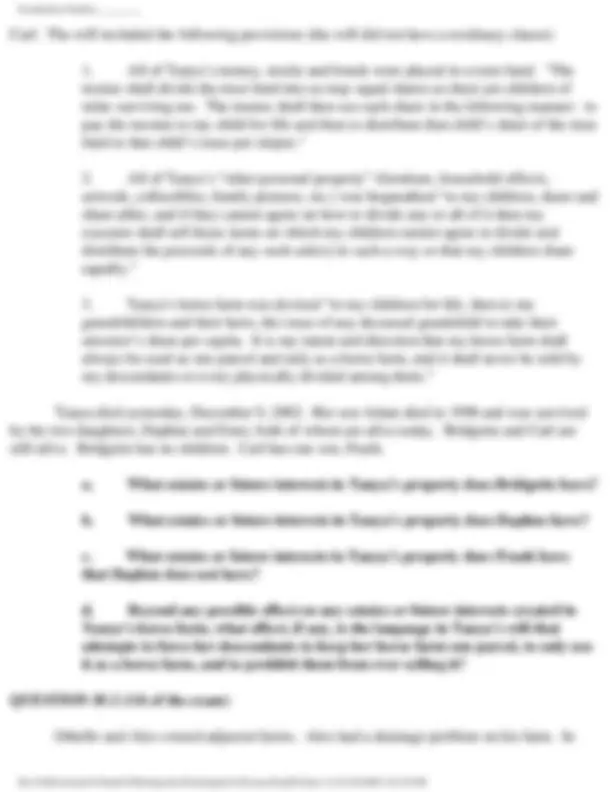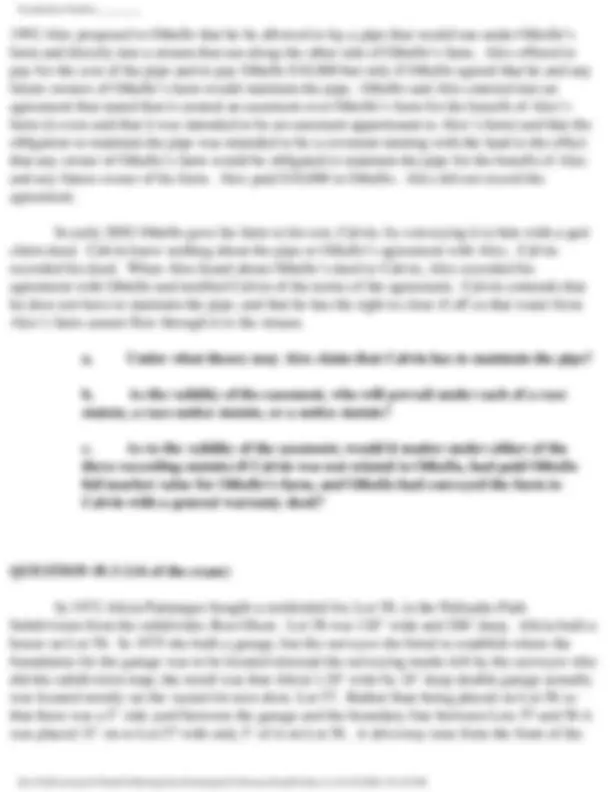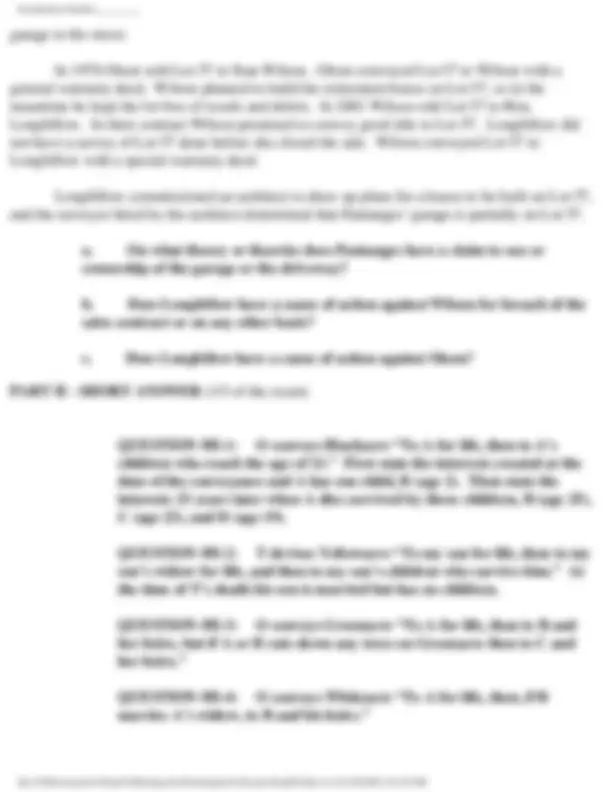





Study with the several resources on Docsity

Earn points by helping other students or get them with a premium plan


Prepare for your exams
Study with the several resources on Docsity

Earn points to download
Earn points by helping other students or get them with a premium plan
Community
Ask the community for help and clear up your study doubts
Discover the best universities in your country according to Docsity users
Free resources
Download our free guides on studying techniques, anxiety management strategies, and thesis advice from Docsity tutors
James Geoffrey Durham, University of Dayton (OH), Law, Property, Exam Fall 2002 Final, present estate, future estate,concurrent estate,assumption,conclusionsossessory Estate,common law Rule Against Perpetuities,future interests.
Typology: Exams
1 / 6

This page cannot be seen from the preview
Don't miss anything!




Examination Number__________
Property - Section 01
FINAL EXAMINATION
Professor J.G. Durham Tuesday, December 10, 2002 1:00 - 4:30 p.m.
a. Question #I-1 counts for one-third (1/3) of your grade on the examination. You should allow about seventy (70) minutes to answer it.
b. Question #I-2 and Question #I-3 each counts for one- sixth (1/6) of your grade on the examination. You should allow about thirty- five (35) minutes to answer each question.
allow about fourteen (14) minutes to answer each question.
a. You are to interpret each disposition with the "post-l536 estates," as that term is used in Nelson & Wendel, A Possessory Estates and Future Interests Primer.
b. At the time of any conveyance/devise the grantor/testator has a fee simple absolute;
c. All recipients of interests are alive at the time of the conveyance/devise, unless otherwise stated;
d. Contingent remainders are not destructible;
e. The Doctrine of Worthier Title and the Rule in Shelley's Case do not apply; and
f. The common law Rule Against Perpetuities is in effect.
(2/3 of the exam)
QUESTION #I-1 (1/3 of the exam)
Tanya executed a will in 1992. At that time she had three children, Adam, Bridgette and
1992 Alex proposed to Othello that he be allowed to lay a pipe that would run under Othello’s farm and directly into a stream that ran along the other side of Othello’s farm. Alex offered to pay for the cost of the pipe and to pay Othello $10,000 but only if Othello agreed that he and any future owners of Othello’s farm would maintain the pipe. Othello and Alex entered into an agreement that stated that it created an easement over Othello’s farm for the benefit of Alex’s farm (it even said that it was intended to be an easement appurtenant to Alex’s farm) and that the obligation to maintain the pipe was intended to be a covenant running with the land to the effect that any owner of Othello’s farm would be obligated to maintain the pipe for the benefit of Alex and any future owner of his farm. Alex paid $10,000 to Othello. Alex did not record the agreement.
In early 2002 Othello gave his farm to his son, Calvin, by conveying it to him with a quit claim deed. Calvin knew nothing about the pipe or Othello’s agreement with Alex. Calvin recorded his deed. When Alex heard about Othello’s deed to Calvin, Alex recorded his agreement with Othello and notified Calvin of the terms of the agreement. Calvin contends that he does not have to maintain the pipe, and that he has the right to close if off so that water from Alex’s farm cannot flow through it to the stream.
a. Under what theory may Alex claim that Calvin has to maintain the pipe?
b. As the validity of the easement, who will prevail under each of a race statute, a race-notice statute, or a notice statute?
c. As to the validity of the easement, would it matter under either of the three recording statutes if Calvin was not related to Othello, had paid Othello full market value for Othello’s farm, and Othello had conveyed the farm to Calvin with a general warranty deed?
QUESTION #I-3 (1/6 of the exam)
In 1972 Alicia Pantanges bought a residential lot, Lot 58, in the Palisades Park Subdivision from the subdivider, Ron Olson. Lot 58 was 120’ wide and 200’ deep. Alicia built a house on Lot 58. In 1975 she built a garage, but the surveyor she hired to establish where the foundation for the garage was to be located misread the surveying marks left by the surveyor who did the subdivision map; the result was that Alicia’s 20’ wide by 24’ deep double garage actually was located mostly on the vacant lot next door, Lot 57. Rather than being placed on Lot 58 so that there was a 5’ side yard between the garage and the boundary line between Lots 57 and 58 it was placed 15’ on to Lot 57 with only 5’ of it on Lot 58. A driveway runs from the front of the
garage to the street.
In 1978 Olson sold Lot 57 to Stan Wilson. Olson conveyed Lot 57 to Wilson with a general warranty deed. Wilson planned to build his retirement house on Lot 57, so in the meantime he kept the lot free of weeds and debris. In 2001 Wilson sold Lot 57 to Rita Longfellow. In their contract Wilson promised to convey good title to Lot 57. Longfellow did not have a survey of Lot 57 done before she closed the sale. Wilson conveyed Lot 57 to Longfellow with a special warranty deed.
Longfellow commissioned an architect to draw up plans for a house to be built on Lot 57, and the surveyor hired by the architect determined that Pantanges’ garage is partially on Lot 57.
a. On what theory or theories does Pantanges have a claim to use or ownership of the garage or the driveway?
b. Does Longfellow have a cause of action against Wilson for breach of the sales contract or on any other basis?
c. Does Longfellow have a cause of action against Olson?
PART II - SHORT ANSWER (1/3 of the exam)
QUESTION #II-1: O conveys Blackacre “To A for life, then to A’s children who reach the age of 21.” First state the interests created at the time of the conveyance and A has one child, B (age 2). Then state the interests 23 years later when A dies survived by three children, B (age 25), C (age 23), and D (age 19).
QUESTION #II-2: T devises Yellowacre “To my son for life, then to my son’s widow for life, and then to my son’s children who survive him.” At the time of T’s death his son is married but has no children.
QUESTION #II-3: O conveys Greenacre “To A for life, then to B and her heirs, but if A or B cuts down any trees on Greenacre then to C and her heirs.”
QUESTION #II-4: O conveys Whiteacre “To A for life, then, if B marries A’s widow, to B and his heirs.”